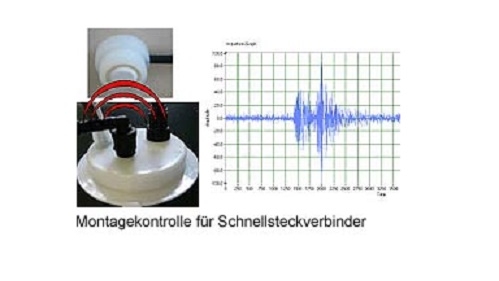Acoustic Process Control

- Acoustic process control for automated monitoring of machining, assembly and joining processes in the production line or in manual test benches for smaller series
- Can also be used for continuous monitoring of machines and systems as well as for condition diagnosis of machine tools and production machines for statistical process control (SPC)
- Applications include mechanical machining processes such as drilling, turning or grinding, joining processes such as friction welding, laser welding or forming as well as the monitored assembly of cables, pipes and valves or of connectors with mechanical latching
Acoustic process control is a non-destructive test method for the production-integrated acoustic monitoring of machining, assembly and joining processes. During mechanical machining by drilling, turning, grinding, sawing, during assembly processes such as press-fitting or snap-fitting, or during joining processes such as friction welding or joining by forming, characteristic vibrations or noises are generated in every process. By recording the acoustic characteristics in terms of frequency and sound level, the body or airborne sound signature is permanently recorded during the process, compared with the known sound signature of processes carried out without defects as a reference, evaluated and a test decision is made or a classification of the test specimen is made. A test system always comprises application-specific selected contacting or non-contacting sound transducers as well as a programmable control and evaluation unit with corresponding software.
Process control is set up by recording the typical sound spectrum of a series of processes running without error. From this data, a sound pattern is calculated and defined as a target value, and the permissible tolerances regarding frequencies and sound levels are determined.
Process monitoring is carried out by means of application-specific selected sound transducers. For this purpose, either contacting acceleration sensors are used, which are e.g. integrated into the workpiece carrier and record the structure-borne sound, or non-contacting systems such as microphones for airborne sound recording or laser or ultrasonic vibrometers for structure-borne sound recording are used.
On the one hand, process monitoring can only take place during the joining process, e.g. by detecting the characteristic clicking noise when a quick-connect connector is snapped into place, on the other hand, continuous monitoring, e.g. of the machining noise of a machine tool, is also possible. The detected noise is compared with the pre-programmed reference pattern. If the deviation from the reference pattern exceeds a pre-set target value, an alarm or error message is issued.
Suppliers: Acoustic Process Control
| Prosensys GmbH Sensorsysteme für die Produktion, Bexbach, Germany |
| RTE Akustik + Prüftechnik GmbH, Pfinztal/ Karlsruhe, Germany |


